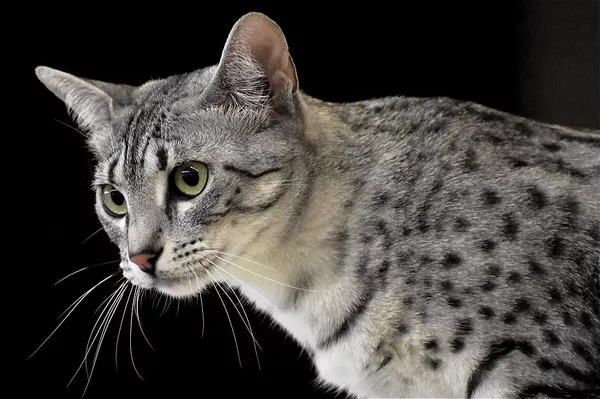Egyptian cats, with their regal presence and mysterious allure, have captivated humans for centuries. While these feline companions are known for their independent nature, training them can be a rewarding endeavor that strengthens the bond between cat and owner. This article delves into effective techniques for training Egyptian cats, providing insights into their unique characteristics and the methods that can foster a harmonious relationship.
Egyptian Cat
Before embarking on the training journey, it’s essential to understand the inherent traits of Egyptian cats. Known for their intelligence, agility, and social nature, these felines thrive on mental stimulation and positive interactions. Recognizing their independent spirit and respecting their need for autonomy lays the foundation for successful training.
1. Positive Reinforcement Techniques
Egyptian cats respond well to positive reinforcement. Reward-based training involves encouraging desirable behaviors through praise, treats, or affection. When your cat displays the desired behavior, such as using a scratching post instead of furniture, immediately reward them with a treat or gentle praise. This reinforces the positive action and encourages the cat to repeat it.
2. Clicker Training
Clicker training is a popular method that pairs a distinct sound, usually from a small handheld device called a clicker, with a reward. The click serves as an immediate marker for the cat, signaling that the behavior exhibited is correct and will be followed by a reward. Consistency is key in clicker training, and it can be particularly effective in shaping more complex behaviors.
3. Patience and Consistency
Training any cat, including Egyptian breeds, requires patience and consistency. Cats may not respond immediately, and it’s essential to avoid punishment, which can create fear and hinder the training process. Instead, consistently reinforce positive behaviors and provide gentle redirection when needed.
4. Interactive Play and Enrichment
Egyptian cats have a playful and curious nature. Incorporating interactive play and environmental enrichment into their routine not only provides mental stimulation but also strengthens the bond between cat and owner. Toys that mimic prey, such as feather wands or laser pointers, can engage their natural hunting instincts.
5. Respect for Independence
While training is valuable, it’s crucial to respect the independent nature of Egyptian cats. They may not always seek constant attention or follow commands like dogs. Creating an environment that allows for autonomy while still encouraging positive behaviors will result in a more content and cooperative cat.
Training Specific Behaviors
1. Litter Box Training:
Begin litter box training early in a cat’s life. Ensure the litter box is easily accessible, clean, and placed in a quiet, private location. If accidents occur, avoid scolding and instead clean the area thoroughly to remove any scent markers that may attract the cat back to the same spot.
2. Scratching Post Training:
Provide an appealing scratching post and encourage its use by placing it near areas where the cat likes to scratch. Use positive reinforcement, such as treats or praise, when the cat uses the scratching post. If inappropriate scratching occurs, gently redirect the cat to the designated post.
3. Basic Commands:
While not as responsive to commands as dogs, Egyptian cats can learn basic commands through consistent training. Use treats or toys as incentives and keep training sessions short to maintain their interest. Commands like “sit,” “stay,” and “come” can be reinforced positively.
4. Harness and Leash Training:
Some Egyptian cats can adapt to harness and leash training, allowing for safe outdoor exploration. Begin by introducing the harness gradually, rewarding positive reactions with treats. Practice indoors before venturing outside, and always ensure the cat feels secure and comfortable in the harness.
Advanced Training Techniques
Beyond basic commands and behavioral training, Egyptian cats can excel in more advanced activities that tap into their intelligence and agility.
1. Agility Training:
Egyptian cats possess a natural agility and grace that makes them well-suited for agility training. Set up a mini-obstacle course with tunnels, ramps, and platforms. Use treats or toys to guide your cat through the course, gradually increasing the complexity of the challenges. This not only provides physical exercise but also stimulates their mental acuity.
2. Clicker Training for Tricks:
Take clicker training to the next level by teaching your Egyptian cat tricks. Start with simple tricks like shaking paws or rolling over. Click and reward when they perform the desired action. With consistent practice, many Egyptian cats can learn an impressive array of tricks, showcasing their intelligence and ability to learn new behaviors.
3. Interactive Puzzle Toys:
Keep your cat mentally engaged by introducing interactive puzzle toys. These toys dispense treats when manipulated correctly, encouraging problem-solving skills. This type of mental stimulation is especially beneficial for Egyptian cats, as it satisfies their natural curiosity and intelligence.
4. Behavioral Challenges:
Create challenges that engage your cat’s mind and body. For instance, hide treats around the house and encourage your cat to find them. This simulates the hunting instinct and provides both physical and mental stimulation. Be patient as your cat learns the game, and gradually increase the difficulty level for added enrichment.
5. Addressing Challenges
While training an Egyptian cat can be a rewarding experience, it’s essential to be aware of potential challenges and how to overcome them.
6. Independence:
Egyptian cats are known for their independent nature. Respect their need for personal space, and avoid forcing them into activities. Training sessions should be short and enjoyable, ensuring that your cat remains engaged and willing to participate.
7. Selective Learning:
Cats may choose when and what to learn, making them appear selectively responsive to training. Be patient and persistent, and tailor your training approach to your cat’s individual preferences and pace.
Conclusion
Training Egyptian cats requires a combination of understanding their unique characteristics, employing positive reinforcement techniques, and respecting their independent nature. The key is to foster a relationship built on trust, patience, and consistent positive interactions. By embracing the intelligence and agility of Egyptian cats, owners can create a harmonious living environment that celebrates the natural behaviors of these captivating feline companions. Whether teaching basic commands, litter box etiquette, or leash walking, the journey of training an Egyptian cat is an opportunity to deepen the bond and enhance the shared joy of companionship.


























